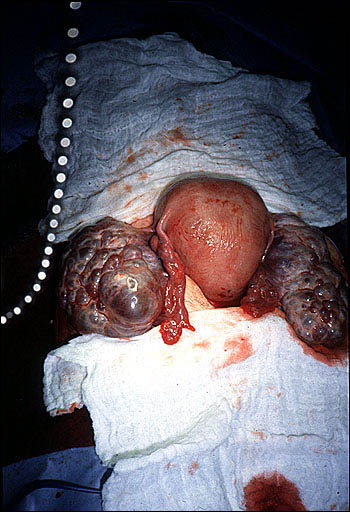 Cyst or Kista
Cyst or Kista
plague cyst, an enlarged organ, and in it contains a liquid, like a balloon filled with water. In women, the most frequent organ is ovarian cysts. No provision whether left or right ovary that often becomes a cyst. In most cases it will not need surgery cyst.
Role of ovarian
Each woman has two ovaries right and left. Normal size of a hazel nut. Each ovary contains thousands of eggs that were young, often called the follicle. Every month one follicle is enlarged and enlarged them very quickly and become a mature egg. In the event of ovulation, a mature egg is out of the ovary and moves into the uterus through the fallopian tubes. If a mature egg is not fertilized, the follicle will shrink and disappear in 2-3 weeks and will continue to repeat according to a woman's menstrual cycle. If there is disruption of this cycle there will be what is called a cyst.
There are 4 kinds of ovarian cysts. Functional cysts, dermoid, chocolate (endometriosis) and cystic glands (Cystadenoma). Until now still not known how the occurrence of cysts. Usually grow very slowly and frequent malignancies in the age over 45 years. Of the four cyst is the most widely and was often shrink themselves in line with the improving of hormonal balance is a functional cyst.Most of the cysts without symptoms and found incidentally at the time of check out a doctor. According to experience, knowing it had ovarian cysts usually when check check-up or at any check because of other reasons.In addition to the typical symptoms for ovarian cysts and is closely related to the type of ovarian cysts.- Functional Cysts. Often without symptoms. Pain symptoms when accompanied by complications such as twisted or broken, but this complication is very rare. Functional cysts are most common and very rarely in the two ovaries. He can shrink itself within 1-3 months.- Dermoid cyst. These cysts occur because of tissue in the eggs are not fertilized. Then grow into tissues such as hair, bones and fat. Cysts can occur in two ovaries and usually without symptoms. Pain symptoms develop if the cyst is twisted or broken.- Chocolate cyst (endometrioma). Occurred because the layer in the uterus (which usually peeling during menstruation and looks out of the genitalia such as blood), located in the uterus but not attached to the outer wall of the ovary. Due to this event each time period, these layers produce menstrual blood, which will continue to accumulate and become cysts. These cysts can be in one or two ovaries. The main symptoms are pain especially during menstruation or sexual intercourse.- Kistadenoma. Originally from the wrapper ovary that grow into cysts. Cysts of this type can also attack the right and left ovaries. The symptoms are usually due to an emphasis on the body around like a bladder that can cause a kind of "beser".What is the Danger?One danger that is feared if the cysts become malignant. Although not all easily turn into a malignant cyst. Based on theoretical studies, functional cysts are most common and very rarely become malignant. Conversely kistadenoma a rare, but easy to become malignant, especially at the age of 45 years or less than 20 years.Another danger of the cyst is when twisted. This incident will cause a feeling of intense pain and require emergency action to prevent the cyst should not be broken. If these cysts rupture can lead to things that are very dangerous for people. [DR. Dr. RM Widjajanto, SpOG]


Tidak ada komentar:
Posting Komentar